
Tyler Weiss and Thomas Schelesny are part of a small but extremely privileged group: they're among the select few people on earth who know how "Game of Thrones" is going to end.
Surprisingly enough, though, both visual effects producers say that no one has ever actually tried to get them to reveal who ends up on the Iron Throne.
"People are excited that we know what's going to happen," Weiss told HuffPost Canada. "But they immediately qualify that with, 'That's very exciting, but don't tell me what happens.'"'
And their ironclad agreements with HBO mean they never would, anyway. "As far as accidentally blabbing, we are well aware that we are working on the Manhattan project," Schelesny added.
Weiss and Schelesny work at the Vancouver visual effects studio Image Engine, which has contributed effects work to HBO's juggernaut "Game of Thrones" since 2014, when the show was going into its fifth season. Since then, they've worked on significant scenes including Barristan Selmy fighting the Sons of the Harpy in Mereen, Jon Snow's execution of Janos Slynt for insubordination, and Arya's revenge murder of sinister Kingsguard member Meryn Trant. They're also responsible for a lot of the texture of the show's world, including the Citadel library and the Wall. Weiss says working on the death scene of sadistic villain Ramsey Bolton, whose face is eaten off by dogs, was a highlight: "everybody wanted to see that."
But by far, the most exciting thing they got to work on was the dragons.

A crew of about 100 people in the Vancouver studio work on the show. They'll be sent the script, along with mood paintings and what they call "pre-visualization" — a very simple, rudimentary animation. From that, they make dragons happen.
The company works off a basic dragon model previously designed by another studio. "We were provided an initial model with some basic colour applied to it, from several seasons ago," Weiss explained. "As the years go on, we all want to raise the bar, make the quality higher, so we basically redo the entire paint job every year."

There are a lot of considerations that come with designing a dragon, Schelesny says, and they try to work with real-world influences whenever possible. "We always start with photographic references of real things and real places, which we can then apply to the computer model," he said. "Things like: how shiny is the surface of a dragon's skin?"
To answer that question, the team would look at photographs of lizards, Schelesny explained, to see how dark their skin was compared to their scales, or how shiny the underside of their necks are compared to the tops of their heads. They went to eagles and bats to determine how to manage the dragons' wings. "We looked at a lot of that photography that was shot in slow motion, so that we could break down the smallest details," he said. For the teeth, they looked at alligators.

Another source of inspiration is airplanes. In Season 7, Drogon, the dragon Daenerys Targaryen usually rides, "was the exact same size as a 747," Schelesny said. "To create this illusion that [the dragon's] wings are flapping and pressing down against the wind, and the membranes between the wing fingers filling with air — all of that is very nuanced work, and an enormous challenge to get it right," he said. So to get a sense of scale, the team drove out to the airport and watched 747s take off and land.
One of the most rewarding scenes they worked on was the "loot train attack," where Daenerys eviscerates her enemies via dragon fire. "When the Dothraki are riding, and then the dragon comes into frame about to kick some ass — everybody freaked out," Weiss said. "Sometimes, we're looking at these shots 500 times a day, so it loses its momentum. It just becomes ten times cooler when you see it on air, and you see other people's reaction."

For Schelesny, coming across YouTube reaction videos to the battle scene felt strangely significant. The one video he remembers reacting to "was a bar full of people screaming and laughing," he said. "I had never, ever seen an audience of the work that we've participated react [like that] — I'd never seen it before, and it literally brought me to tears."
More from HuffPost Canada:
Working on the current season, Schelesny says he keeps thinking about those viewers. "I feel like I owe something to that same crowd of drunk people to re-deliver."
When asked what they're most proud of on the series, they both demurred.
"We're not allowed to talk about it," Schelesny said. "It only gets better."
Also on HuffPost: